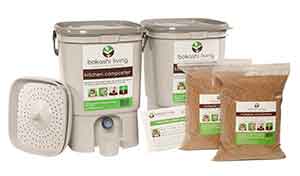Think composting is reserved for people who have sprawling gardens and large yards? Think again. The breakdown of organic materials into finished compost is a complex process, but the act of actually making it doesn’t have to be. And you don’t need a lot of room to do it either.
It turns out the type of dwelling one lives is a huge deciding factor when it comes to composting kitchen waste. Statistics Canada found 50 percent of households in single-family homes reported composting, compared to only 22 percent of those living in apartments or condo complexes. Without access to a yard or private gardens, many apartment dwellers believe composting isn’t an option.
We Can All Pitch In
The thing is, we all need to do our part, no matter where or what we call home. Food waste is a huge problem in our society; in 2014 alone, the EPA estimates Americans wasted 38 million tons of food, with only about five percent being diverted from landfills.
North of the border, Environment Canada says biodegradable materials make up 40 percent of all residential waste. Precious kitchen scraps end up tightly-sealed in landfills, where they decompose and emit methane into the atmosphere, a greenhouse gas 30 times more potent than CO2. One-third of our greenhouse gas emissions could be mitigated if we all made a pact to return our organic materials back to the soil.
Size Doesn’t Matter!
Even if you live in a high-rise without a yard, surely you must have some house plants that would greatly benefit from compost? If you don’t, many community gardens and farmer’s markets will gladly accept donations of organic matter.
Wiggly Worms
There are a couple of very easy ways to compost indoors; small-scale bins are readily available on the market. But the best alternative by far is vermicomposting, or worm composting. This method doesn’t require a lot of space; it can be done on a small balcony, garage, or even indoors! Using worms has been found to be the most efficient way to compost kitchen waste; they can break down organic matter incredibly fast, and thanks to secretions from their intestinal tracts, the resulting humus contains five times more nitrogen, seven times more phosphorus and 11 times more potassium than normal compost. That’s the stuff plant dreams are made of.
There’s a great chapter on vermicomposting in the book Compost: How to make and use organic compost to transform your garden. Author Clare Foster points out it’s important to use small red worms, known as the tiger or brandling worms for your compost; never earthworms. It’s best to buy them from worm farms or organic supplies as you will need about 2,000 of them to start a worm bin. Be sure to set up a nice environment for them; in addition to regular helpings of kitchen waste, the worms need high-fiber bedding material, such as shredded newspaper. To keep vermin and fruit flies at bay, you’ll need to bury your food scraps in this bedding.
There are so many options to choose from when buying a vermicompost bin, but Foster says making one yourself is also possible.
 Bokashi Composting
Bokashi Composting
Another method that is rising in popularity amongst city-dwellers is bokashi composting. This is touted as a process of fermentation that generates specialized microbes, yeast, and fungi that deliver high-quality compost. It can be done in your kitchen; the small compost bin would fit on any countertop. Another benefit is bokashi claims to compost ALL food scraps, including meat, dairy, and grains, although be warned, adding those to traditional compost is a recipe for disaster. It ends up smelling bad and could attract vermin.
Think Green and Brown
Keep in mind, traditional composting, and vermicomposting, only work with a very strict list of kitchen and yard waste. I had an interesting conversation with the Compost Council of Canada, in which I was told one of the main challenges of large-scale compost initiatives (mainly in urban areas) is people tend to treat the bin as another garbage. Remember: what you take from the soil, you must put back in. Never ditch things in your compost bin that won’t break down!
- Common “green” or “wet” materials include fruits and vegetables, tea leaves, coffee grounds, and prunings from plants and grass clippings.
- “Brown” or “dry” materials include dried leaves, coffee filters, shredded paper and small branches.
- When making your compost, try to achieve a 1 to 10 ratio of dry to wet in your bin.
I get it; living in smaller spaces without access to a backyard make many things more challenging, especially composting. But you can make a real difference by properly recycling kitchen waste; small-scale compost options are readily available, and it’s actually not that hard!
Don’t be scared of the worms; there are so many scarier things out there… like greenhouse gases.
 Bokashi Composting
Bokashi Composting